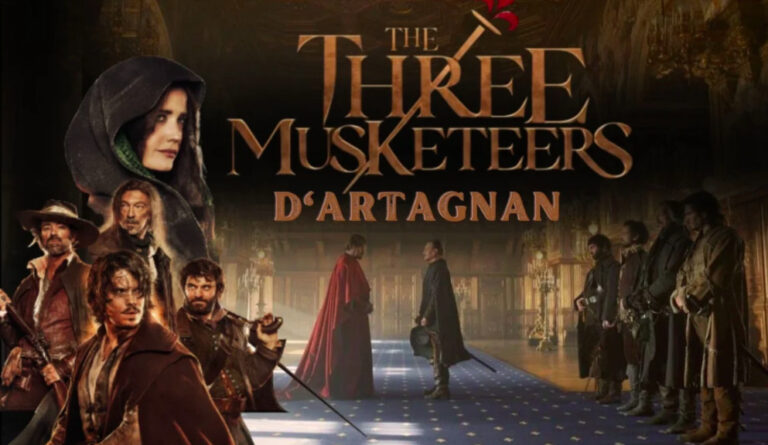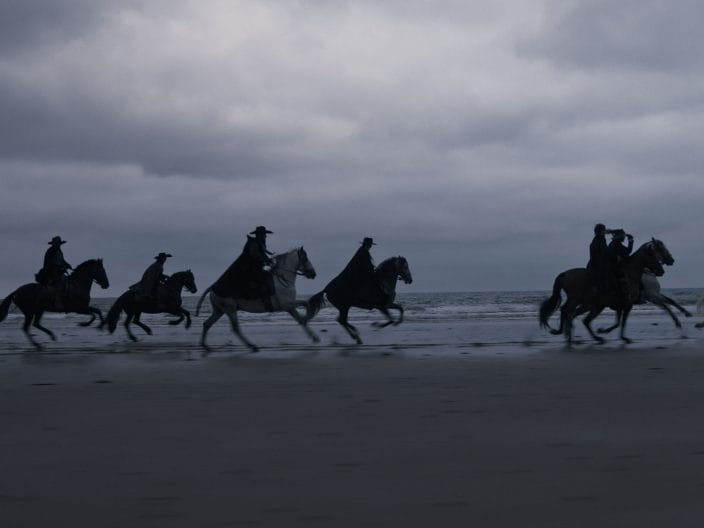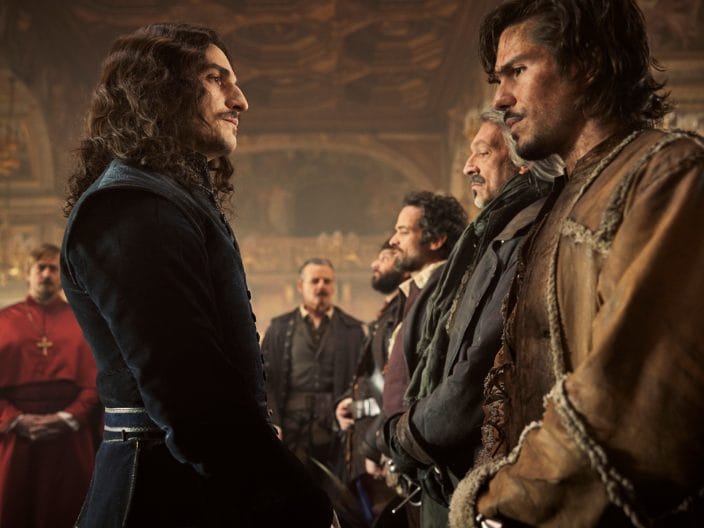
The 1844 novel by Alexandre Dumas gets another screen adaptation with The Three Musketeers: D’Artagnan directed by Martin Bourboulon. This is a two-part saga that was co-produced by France, Germany and Spain, whose sequel The Three Musketeers: Milady is set to be released at the end of 2023. This second part will introduce a new character, Hannibal (Ralph Amoussou), based on the true story of Louis Anniaba, the first Black musketeer in French history. So far the first part of the film saga presents a plot that is very familiar and follows the original source by the book.
During the France of Louis XIII, Charles de Batz de Castelmore d’Artagnan (François Civil), is a lively young man from Gascony who is left to die after he tries to save a girl from a kidnapping. He survives and arrives in Paris, where he tries to track down the attackers. During his pursuit, D’Artagnan gets acquainted with those who will become his partners-in-crime, the three Musketeers: Count Athos Olivier de Bragelonne de La Fère (Vincent Cassel), Porthos du Vallon (Pio Marmai) and Aramis d’Herblay (Romain Duris).
The four men will face the machinations of Cardinal Armand-Jean du Plessis de Richelieu (Eric Ruf) and his personal spy Milady de Winter (Eva Green). As D’Artagnan finds himself in the heart of a real war that puts the future of France at stake, he falls in love with Constance (Lyna Khoudri), the confidant of the Queen (Vicky Krieps).
The list of screen adaptations of The Three Musketeers is bountiful, but this did not intimidate French filmmaker Martin Bourboulon, who does justice to the writer who first brought these characters to life, as well as the historical context. The misty cinematography by Nicolas Bolduc gives an authentic feel of what life could have been during the 17th century: dark and illuminated by candles or oil lamps emerging from dense darkness. The mystery and intrigues of politics very much align with this obscurity. The production design by Stéphane Taillasson and Patrick Schmitt in unison with the costumes by Thierry Delettre complete the efficacy of catapulting audiences back to the year 1625.

The character construction and unravelling of events is very well penned by screenwriters Matthieu Delaporte and Alexandre de La Patellière, who faithfully follow Alexandre Dumas’ spirit and revive the swashbuckler genre, characterised by heroic and chivalrous swordsmen fighting for justice. It is the very themes represented by the Musketeers of the Guard that allows their story to never get boring and withstand the test of time. The complementarity of the iconic protagonists is beautifully reprised by François Civil, Vincent Cassel, Romain Duris and Pio Marmai. Thus, the coming-of-age of the youngest of the musketeers runs parallel to their personal stories: Athos is tormented by remorse, shame and guilt; Aramis is a sincere lover torn between faith and women; Porthos is devoted to sensual pleasures whether they come from food and drink or intimacy with men or women.The sense of honour and brotherhood shared by this military quartet are values that even the youngest of generations can relate to during the 21st century.
Furthermore the female characters in the story (Milady, Constance and the Queen) present a very modern version of freewheeling ladies, each according to their status and role in society. Eva Green is sublime as Milady, the intrepid and diabolical plotter who conceals a weighty past that has forged her into the femme fatale warrior she has become. A similar spirit of initiative belongs to Constance, played by Lyna Khoudri who welds a pure spirit with bold courage and devotion to her monarch. The latter is embodied by the actress grown to fame through the historical drama, Corsage. Vicky Krieps has disrobed herself from the costume of the Empress Elisabeth of Austria, to fill the shoes of another iconic royal woman married to the King of France but secretly in love with the Duke of Buckingham — graciously played by Jacob Fortune-Lloyd.

One of the most impressive performances is by Louis Garrel who amuses for the snotty, uptight and discombobulated depiction of the sovereign. His character construction of the French monarch reminisces the description of the biography of Louis XIII written by Jean-Christian Petitfils, who tried to rehabilitate this figure that was eclipsed by the panache of his father Henri IV and overshadowed by the dazzling fame of his son Louis XIV. The inferiority complexes of Louis XIII towards his father, inspired Dumas to portray him as a docile character who was utterly under Cardinal Richelieu’s control. But in Bourboulon’s film, Louis XIII is left to decide whether to declare war on England or not and evaluate if he is cuckolded by his spouse.
Amongst the talented cast, also worthy of mention are Eric Ruf for the way he captures the intelligence and duplicity of Richelieu as the éminence grise, as well as Alexis Michalik playing Villeneuve de Radis, Patrick Mille as Henri de Talleyrand-Périgord, and Ivan Franek as Ardanza.
The Three Musketeers: D’Artagnan is a glorious celebration of its titular character and all the ideals he represents, from loyalty to temerity, from naiveté to passion. Beyond this character, Martin Bourboulon fully celebrates Alexandre Dumas’ universe in an almighty manner that could be summed up a French word: puissance.
Final Grade: B+

